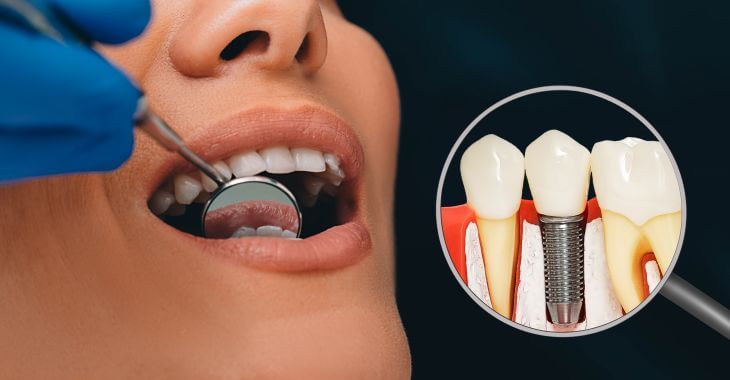What Are the Different Gum Disease Stages?

Gum or periodontal disease is the most common cause of tooth loss, but it causes many other problems. Gum disease can lead to bone loss in the jaw, which impacts the facial structure and appearance. It can also increase risk for serious health problems like cardiovascular disease, type 2 diabetes and stroke. Understanding the gum disease stages and what you can do to stop or slow the progression can minimize the impact on your oral and overall health.
Periodontal disease is fueled by a bacterial infection of the gum tissue. Bacteria are always present in the mouth, but if they flourish due to lack of proper oral hygiene or other factors, it can impact the health of the gums. Gum disease begins when bacteria on the teeth create plaque and tartar as they feed on food debris, which can result in inflammation of the gums. If left uncontrolled, periodontal disease can lead to a host of oral health issues during the different stages of gum disease.
Stage of Gingivitis
The first of the early stages of gum disease is gingivitis. The stage of gingivitis is characterized by inflammation of the gums, usually due to poor oral hygiene. The bacteria that cause plaque and tartar to form on the teeth create acids that irritate the gum tissue. Gums around the teeth can become slightly swollen and may recede slightly, creating periodontal pockets around the teeth. Some of the symptoms of gingivitis can include bleeding while brushing, redness and possibly, bad breath. Catching gum disease at the gingivitis stage is reversable with treatment.
Early Stages of Gum Disease
Early periodontitis or gum disease is a more serious level of gum infection than gingivitis. The stage of gingivitis is limited to infection of the gum tissue, but it does not affect the bone surrounding the teeth. In the early stages of the gum disease periodontitis, the infection of the gum tissues increases and spreads to the other oral tissues. Some of the symptoms of early periodontitis include:
- Deeper periodontal pockets around the teeth (4-6mm)
- Gums begin to separate from the teeth
- Plaque and tartar under the gum line
- Bad breath or taste in mouth
- Beginning of bone loss
- Fibrous tissues supporting teeth begin to deteriorate
Once early periodontitis begins, it can permanently damage fibers in tissue and cause bone loss around the teeth. However, while it cannot be reversed at this point, there are still effective treatments to stop the infection and oral damage.
Moderate Periodontitis
When gum disease stages progress to moderate periodontitis, there is a noticeable change in the health of the teeth and gums. The connective tissues and bone around the teeth begin to deteriorate further to the point of impacting the stability of the teeth. Periodontal pockets around the teeth increase to 6-7mm and the roots of the teeth may be visible, making the teeth appear longer. Teeth may be more sensitive due to root exposure and patients may experience halitosis, or chronic bad breath.
In moderate periodontitis, there can be tooth abscesses and up to 50% bone loss around teeth. The teeth can loosen and shift, creating the appearance of separation between the teeth. Treatments for moderate periodontitis gum disease stages are more invasive and may require oral surgery.
Advanced Stages of Gum Disease
Advanced periodontitis is the final stages of gum disease. Patients with advanced periodontitis will likely have chronic bad breath, bleeding gums (often spontaneously), loosened teeth and sensitive teeth. The teeth begin to drift in position and eventually teeth will be lost. The periodontal pockets are 7mm or greater and bone loss is severe, over 50%. Pus may drain into the mouth from tooth abscesses caused by periodontal disease. Eventually, teeth will begin to fall out and the facial structure may be changed by bone loss.

Treatment in the Early Stages of Gum Disease
Periodontal disease affects almost 50% of adults over the age of 30. It is the number one cause of tooth loss, and the bacteria can enter the bloodstream, impacting overall health. The best way to stop or slow this condition is with treatment in the early gum disease stages. Daily oral hygiene combined with regular checkups and dental cleanings at least twice a year can reverse the disease in the early stage of gingivitis. Once periodontitis is present, there are treatments like root planing, medications and surgery to control the disease.
The stages of gum disease occur over many years and there are options to prevent it from progressing to advanced periodontitis. To protect your oral and overall health from gum disease, start with good oral hygiene habits at home and see your dentist for routine dental cleanings and checkups. If you have symptoms of any of the gum disease stages, your dentist can begin a periodontal disease treatment plan to improve your oral health.
The information provided on this website, including text, graphics, images, and other materials, is intended solely for informational purposes and should not be used as a substitute for professional medical advice, diagnosis, or treatment.




)